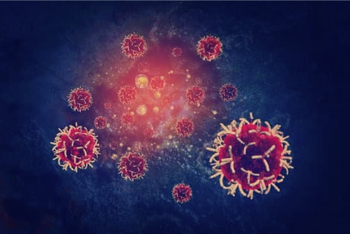
Oncology NEWS International
- Oncology NEWS International Vol 10 No 5
- Volume 10
- Issue 5
Fulvestrant Compares Favorably to Anastrozole in Two Clinical Trials
SAN ANTONIO-Fulvestrant (Faslodex), an estrogen-receptor (ER) downregulator (see Figure), appears to be at least as good as the aromatase inhibitor anastrozole (Arimidex) as second-line therapy in postmenopausal women with advanced breast cancer who had progressed or recurred on prior endocrine therapy.
SAN ANTONIOFulvestrant (Faslodex), an estrogen-receptor (ER) downregulator (see Figure), appears to be at least as good as the aromatase inhibitor anastrozole (Arimidex) as second-line therapy in postmenopausal women with advanced breast cancer who had progressed or recurred on prior endocrine therapy.
The preliminary results of two phase III clinical trials comparing the two agents were presented at the 23rd Annual San Antonio Breast Cancer Symposium. Based on these trial results, AstraZeneca, manufacturer of fulvestrant, has submitted a new drug application to the FDA requesting priority review for this indication.
In the North American trial, the median duration of response in the ful-vestrant arm was 19.3 months, compared with 10.5 months in the anastrozole arm. Patients were followed for a median of 16.8 months.
In the European study, the median duration of response in the two arms was almost identical, with 434 days (14.5 months) for fulvestrant and 425 days (14.2 months) for anastrozole. Patients were followed for a median of 305 days (10.2 months).
"Faslodex is the first antiestrogen with significant clinical benefit in tamoxifen-resistant advanced breast cancer," said J.F.R. Robertson, MD, of City Hospital, Nottingham, UK. "It is at least as effective as Arimidex."
Dr. Robertson presented the findings of the European study on behalf of the scheduled speaker, Anthony Howell, MD, who could not be present. "It is a new treatment option for postmenopausal women with advanced breast cancer," Dr. Robertson said.
Fulvestrant is a pure antiestrogen, the first in a new class of antiestrogens that works by targeting and degrading the estrogen receptor rather than blocking it as with tamoxifen (Nolvadex).
The two studies had a similar design. Both were multicenter, randomized trials. Patients in both received either 250 mg of fulvestrant intramuscularly once monthly or 1 mg of anastrozole daily. The primary distinction between the studies was that the North American study was a double-blind, double-dummy study while the European study was not blinded.
There were also some slight differences in patient characteristics between the two studies. The North American study included more ER-positive patients. The American patients were also 5 to 10 lb heavier than the European patients.
In the North American study, 400 patients were recruited between May 1997 and August 1999. Since this was a double-dummy trial, women in the anastrozole arm also received placebo injections while women in the fulvestrant arm also received placebo pills.
In addition to the 9-month advantage in duration of response that fulvestrant demonstrated in this trial, the median time to progression was slightly longer with fulvestrant5.4 months and 3.4 months in the fulvestrant and anastrozole arms, respectively (not significant).
An evaluation of deterioration in quality of life, an "important but difficult endpoint," showed no statistically significant differences between the two arms, said C. Kent Osborne, MD. Dr. Osborne presented the results of the North American trial on behalf of the North American Faslodex Investigator Group, Baylor College of Medicine, Houston.
"Faslodex is as effective as Arimidex for primary and secondary endpoints," Dr. Osborne said. "It is active in tamoxifen-resistant patients, as predicted."
In the European study, 451 patients were recruited between June 1997 and September 1999 and randomized to receive either fulvestrant (n = 222) or anastrozole (n = 229). The median time to progression was similar in both groups167 days (5.6 months) and 156 days (5.2 months) for fulvestrant and anastrozole, respectively.
Both treatments were well tolerated. In the North American trial, 2.5% of fulvestrant patients and 2.6% of anastrozole patients withdrew due to adverse events, Dr. Osborne said. Side effects for fulvestrant and anastrozole, respectively, included the following: hot flushes, 23.5% and 24.9%; gastrointestinal disturbances, 56% and 56.2%; weight gain, 1.5% and 1.6%; and vaginitis, 3.4% and 2.6%. The European investigators reported similar toxicity results.
Articles in this issue
over 24 years ago
Adjuvant Chemo Dose Reductions Frequent in Breast Cancerover 24 years ago
Women May Be at Greater Risk for Undertreatment of Cancer Painover 24 years ago
Umbilical Cord Blood in Adult Leukemia Patientsover 24 years ago
Irinotecan Results Continue to Be Encouraging in Colorectal Cancerover 24 years ago
Irinotecan Active in Pediatric Cancersover 24 years ago
Ultrasound Contrast Agents Help Diagnose Prostate Cancerover 24 years ago
Optimal Use of Irinotecan Still to be Determinedover 24 years ago
Groups Urge Federal Action Against Eclipse Cigarettesover 24 years ago
Potential Advantages of Oral Irinotecan Defined in Phase I StudiesNewsletter
Stay up to date on recent advances in the multidisciplinary approach to cancer.




















































































